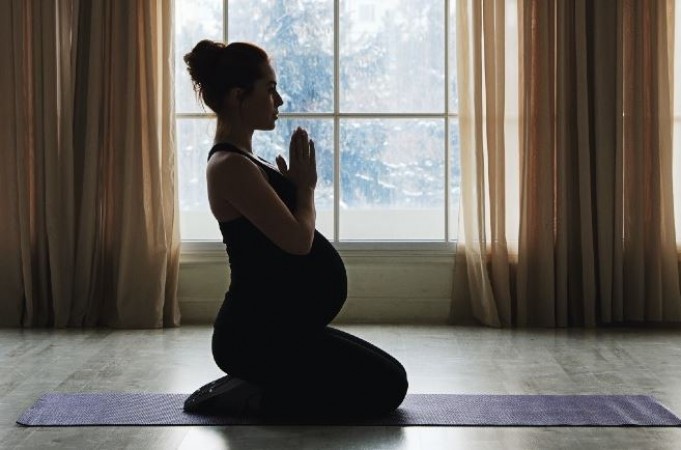
Pregnancy is a time of profound change, and practicing gentle and safe yoga asanas can offer a multitude of benefits for expectant mothers. While engaging in yoga during pregnancy can enhance flexibility, alleviate discomfort, and promote relaxation, it's vital to approach these poses with mindfulness and adhere to the guidance of a certified prenatal yoga instructor. In this comprehensive guide, we'll delve into each of the recommended yoga asanas for pregnancy, discussing their advantages, necessary precautions, and potential risks.
1. Cat-Cow Stretch (Marjariasana-Bitilasana):
The Cat-Cow stretch, a dynamic duo of poses, involves arching and rounding the spine in sync with the breath. It brings several benefits to pregnant women, including gentle spinal flexibility that relieves backaches and promotes blood flow to the abdominal area, nurturing the growing fetus. Precautions include moving mindfully to prevent over-extension of the back. Maintain a rhythmic breath to encourage relaxation. While the pose is generally safe, avoid excessive rounding of the back, particularly as pregnancy progresses.
2. Butterfly Pose (Baddha Konasana):
The Butterfly Pose is particularly helpful in preparing the hips for childbirth. By gently opening the hips and groin, it eases tension in this area and fosters flexibility. The posture also aids in stimulating the reproductive organs and enhancing circulation. To practice, ensure that the knees are comfortable and avoid applying excessive pressure to bring them closer to the ground. This pose is usually safe, but as pregnancy advances, it might become less comfortable. Modify the pose as needed to align with your comfort level.
3. Modified Camel Pose (Ustrasana Variation):
This variation of Camel Pose is tailored to suit the unique needs of pregnant women. It entails a gentle backward stretch to alleviate tension in the chest and shoulders. By encouraging a sense of openness, it can also alleviate the tightness that sometimes accompanies pregnancy. To ensure safety, opt for a mild backbend that doesn't strain the abdominal area. Pay attention to the limits of your body and avoid overexerting yourself.
4. Supported Warrior II (Virabhadrasana II with Support):
Supported Warrior II is a stabilizing pose that enhances balance and strengthens the legs. It can be particularly beneficial for promoting strength and stamina during pregnancy. Use a chair or a wall for added support, which ensures stability and prevents unnecessary strain on the pelvic region. This pose is generally safe with proper support, but avoid excessive effort that could lead to discomfort.
5. Side-Lying Savasana:
A restful and comfortable pose, Side-Lying Savasana provides relaxation and relieves fatigue that can accompany pregnancy. As the body undergoes changes, this pose offers a serene respite. Utilize props like pillows to support the head, neck, and body, ensuring optimal comfort. This pose is generally safe and offers restorative benefits.
6. Modified Triangle Pose (Trikonasana Variation):
The Modified Triangle Pose is designed to provide a gentle stretch to the sides of the body and open the chest. As it engages the legs and stretches the torso, it offers a balanced experience. For safety, place a block or support under the bottom hand to prevent excessive strain on the abdomen. Approach this pose with moderation, avoiding deep twists and undue strain.
7. Child's Pose (Balasana):
Child's Pose is a nurturing posture that facilitates a gentle stretch for the back and hips. It offers a quiet moment of relaxation and release. To ensure safety, use supportive props under the head and torso, creating a comfortable and secure space. Child's Pose is generally regarded as safe and comforting throughout pregnancy.
8. Prenatal Yoga Poses with Wall Support:
Utilizing wall support during pregnancy can offer added stability and comfort. Gentle poses such as standing stretches and pelvic tilts can be practiced with the wall as a guide. This approach prevents overexertion and encourages a safe and mindful practice. With wall support, these poses are generally safe and provide relief.
Engaging in yoga asanas during pregnancy can be a source of both physical and emotional nourishment. The recommended poses cater to the unique needs of expectant mothers, promoting flexibility, alleviating discomfort, and fostering relaxation. However, it's paramount to prioritize safety and consult with a healthcare professional before embarking on a yoga practice. Certified prenatal yoga instructors can offer invaluable guidance, ensuring that expectant mothers engage in a practice that is supportive, nurturing, and tailored to their well-being. By approaching each pose mindfully, listening to your body, and practicing with awareness, you can embrace the transformative journey of pregnancy with greater ease and comfort.
Avoid purchasing personal care products with these words on the label
Homemade Hair Masks for Hair Loss Prevention
Mango to Banana: 6 Fruits to Avoid for Weight Loss